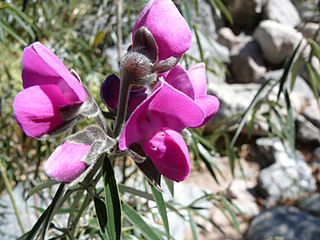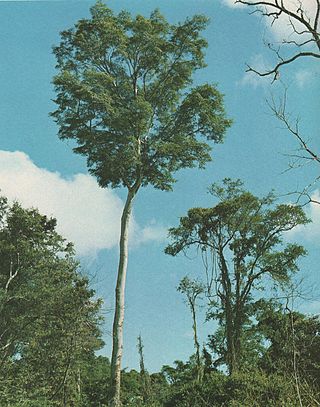
The Mimosoideae are a traditional subfamily of trees, herbs, lianas, and shrubs in the pea family (Fabaceae) that mostly grow in tropical and subtropical climates. They are typically characterized by having radially symmetric flowers, with petals that are twice divided (valvate) in bud and with numerous showy, prominent stamens.

The Faboideae are a subfamily of the flowering plant family Fabaceae or Leguminosae. An acceptable alternative name for the subfamily is Papilionoideae, or Papilionaceae when this group of plants is treated as a family.

Camoensia is a genus of 2 species of lianas in the family Fabaceae, subfamily Faboideae, native to the Gulf of Guinea, Africa. C. scandens is cultivated as an ornamental plant; it has one of the largest leguminous flowers, up to 20 cm across. The genus has classically been assigned to the tribe Sophoreae, but was recently assigned to its own monophyletic tribe, Camoensieae, on the basis of molecular phylogenetic evidence. Species of Camoensia are known to produce quinolizidine alkaloids, consistent with their placement in the genistoid clade.

Brya is a genus of flowering plants in the legume family, Fabaceae. It includes seven species of shrubs or small spreading trees native to Cuba and Hispaniola in the Caribbean. It belongs to the subfamily Faboideae, and was recently assigned to the informal monophyletic Pterocarpus clade of the Dalbergieae. Species include Brya ebenus, a valuable timber tree.

Camptosema is a genus of flowering plants in the legume family, Fabaceae. It includes five species native to South America, ranging from northeastern Brazil to Bolivia and northeastern Argentina. It belongs to the subfamily Faboideae and tribe Diocleae.

Collaea is a genus of flowering plants in the legume family, Fabaceae. It belongs to subfamily Faboideae and tribe Diocleae. It includes five species native to the southern tropical South America, ranging from Peru to northeastern Brazil and northeastern Argentina.

Cymbosema is a genus of flowering plants in the legume family, Fabaceae. It includes a single species, Cymbosema roseum, a liana native to the tropical Americas. It ranges from southeastern Mexico to Bolivia and northeastern and west-central Brazil. Typical habitats include tropical lowland rain forest and riverine forest.

Galactia is a genus of plants in the legume family (Fabaceae). It belongs to the subfamily Faboideae and tribe Diocleae They do not have an unambiguous common name, being commonly called milk peas, beach peas or wild peas. They are perennial herbs or subshrubs with prostrate, climbing, or erect forms.

Harpalyce is a genus of flowering plants in the family Fabaceae. It belongs to the subfamily Faboideae. It includes 35 species of shrubs and small trees native to the tropical Americas. Their distribution is disjunct, ranging from Mexico to Nicaragua, Cuba, and northern to southeastern Brazil and Bolivia. Typical habitats include seasonally-dry tropical forest, warm-temperate humid forest, woodland, bushland and thicket, shrubland, and grassland. Most species are evergreen and flower during the dry season.
Leucomphalos is a genus of flowering plants in the legume family, Fabaceae. It contains a single species, Leucomphalos capparideus, a climbing perennial shrub native to the Guineo-Congolian forest of Nigeria, Cameroon, Equatorial Guinea, Gabon, and the Gulf of Guinea Islands. It belongs to the subfamily Faboideae. Leucomphalos was traditionally assigned to the tribe Sophoreae; however, recent molecular phylogenetic analyses reassigned Leucomphalos to the Baphieae tribe.

Luetzelburgia is a genus of flowering plants in the legume family, Fabaceae. It includes 14 species of trees and shrubs native to Brazil, Bolivia, and Colombia. Typical habitat is seasonally-dry tropical lowland woodland and wooded grassland, and occasionally lowland rain forests. The genus belongs to the subfamily Faboideae. It was traditionally assigned to the tribe Sophoreae, mainly on the basis of flower morphology; recent molecular phylogenetic analyses assigned Luetzelburgia into an informal, monophyletic clade called the "vataireoids". Keys for the different species of Luetzelburgia have been published.

Macropsychanthus is a genus of flowering plants in the legume family, Fabaceae. It belongs to the tribe Diocleae, subfamily Faboideae. The genus has 47 species with a pantropical distribution, ranging through the tropical Americas from southern Mexico to northeastern Argentina, west and central Africa, Madagascar, Indochina, Malesia, Papuasia, and Queensland.
Petaladenium urceoliferum is a species of flowering plant in the family Fabaceae. It is a tree native to northern Brazil. It grows in tropical lowland Amazon rainforest in the basin of the Rio Negro, a northern tributary of the Amazon. It is the only member of the genus Petaladenium. The genus belongs to tribe Amburaneae in subfamily Faboideae.
Pictetia is a genus of about eight species of trees and shrubs in the family Fabaceae with spiny stems and spine-tipped leaflets. The genus is endemic to the Greater Antilles, but its closest relatives are in Mesoamerica and Africa.

The tribe Dalbergieae is an early-branching clade within the flowering plant subfamily Faboideae. Within that subfamily, it belongs to an unranked clade called the dalbergioids. It was recently revised to include many genera formerly placed in tribes Adesmieae and Aeschynomeneae and to be included in a monophyletic group informally known as the dalbergioids sensu lato. The members of this tribe have a distinctive root nodule morphology, often referred to as an "aeschynomenoid" or "dalbergioid" nodule.

The tribe Amburaneae is one of the subdivisions of the plant family Fabaceae. It has been circumscribed to include the following genera, which used to be placed in tribes Sophoreae and Swartzieae:

The tribe Diocleae is one of the subdivisions of the plant family Fabaceae.
Bowringia is a genus of flowering plants in the legume family (Fabaceae), found in tropical Africa and southeastern Asia. It includes four species native to western and central Africa and Madagascar, and to Borneo, Indochina, and southern China.

Guilandina is a genus of flowering plants in the legume family, Fabaceae. It belongs to the subfamily Caesalpinioideae and tribe Caesalpinieae.
Denisophytum is a genus of flowering plants in the family Fabaceae. It belongs to subfamily Caesalpinioideae and tribe Caesalpinieae. It includes eight species, which have a disjunct distribution – northern Mexico, Florida and the Caribbean, southern South America, the Horn of Africa, the Arabian Peninsula, and Madagascar.














